
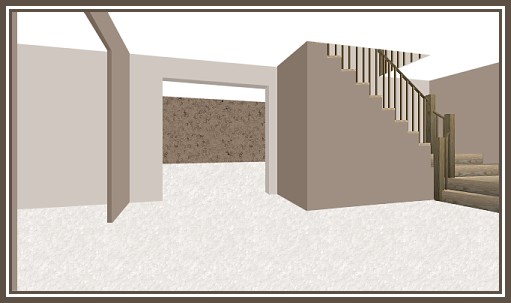
This tut also, isn't a very difficult one. I have included the stairs, carpet fill and wallpaper fill for you. I made the stairs in another programme I own called "Architectural Series 18" created by
Punch. I use it to make houses and decks and some room shapes. This is the same programme I used to make the house images I have offered for your use as well.
At the end I have included a quickie sample of how I decorated this as a lower or basement family room area. You could also treat this as if it was a foyer and then possibly a dining room off to the left and the living room straight ahead. I also showed you two alternatives that could be achieved with a couple of easy steps.
I place absolutely NO restrictions on the use of this tutorial or your finished image, except for reproducing the tutorial on your own site without permission or claiming it as your own.
This tutorial was completed using PSP7 but can easily be done in PSP6 or 8 I am sure.
What You Will Need:
Paint Shop Pro: download a trial version here
Zip of my image files: you can download it here
Zip of my selections: you can download it here
PLEASE save your work often!! I did it after every layer. It is better to be safe than sorry. You don't know how many times I still forget this and have to start all over again.
(1) Open a new image 650 x 372, 16 mil colours, transparent background.
(sorry for the odd second number)
(2) Create a new layer and call it "carpet."
Load selection "carpet.sel"
Open the carpetfill image provided in the zip and floodfill at 100 size, angle 0.
(3) Create a new layer and call it "back ceiling"
Load selection "backceiling.sel"
Floodfill with white.
(4) Create a new layer called "backwall"
Load selection "backwall.sel"
Open the wallpaperfill image provided in the zip and floodfill at 100 size, angle 0.
(5) Create a new layer called "middle shadow side"
Load selection "midshadowside.sel"
Floodfill with #D0C8C0 and then adjust the brightness only to minus 25
(6) Create a new layer called "middle shadow top"
load selection "midshadowtop.sel"
Floodfill with #D0C8C0 and then adjust the brightness only to minus 40
(7) Create a new layer called "middle wall"
load selection "middlewall.sel"
Floodfill with #D0C8C0
(8) Create a new layer called "upper stair wall"
Load selection "upperstairwall.sel"
Floodfill with #D0C8C0
(9) Create a new layer called "front right wall"
load selection "frontrightwall.sel"
Floodfill with #9E8F82
(10) Create a new layer called "tiny railing"
load selection "tinyrailing.sel"
Open the image of the railing from the zip and copy it.
Return to the main image, and while holding down the shift key and the control key, press the L key
This is the shortcut for pasting a copied image right into a selection.
(11) Create a new layer called "front ceiling"
Load selection "frontceiling.sel"
Floodfill with white.
(12) Create a new layer called "left wall edge"
load selection "leftwalledge.sel"
floodfill with colour #9E8F82 and adjust the brightness to minus 25
(13) Create a new layer called "left edge top"
load selection "leftedgetop.sel"
floodfill with colour #9E8F82 and adjust the brightness to minus 40
(14) Create a new layer called "left partial wall"
load the selection "leftpartialwall.sel"
Floodfill with #9E8F82
(15) Create a new layer called "stairs"
Open the image of the stairs from the zip and copy it.
Return to the main image, and while holding down the shift key and the control key, press the L key
This is the shortcut for pasting a copied image right into a selection.
(16) Create a new layer called "stair backing"
load selection "stairbacking.sel"
floodfill with colour #9E8F82 and adjust the brightness to minus 25
You are now finished the basics so I hope you have fun filling the space with furniture and decorations.
Remember, if you ever think you might decorate or use this room again, save the original with all the layers in psp format. Then duplicate it and work on decorating the copy.
Here is the sample I decorated for you just to give you an idea of how it might look with furniture.
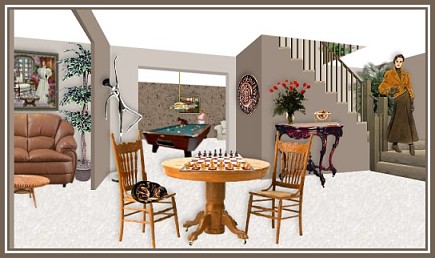
Here is an alternate look you can achieve by just forgetting to do the 3 layers for the left wall.
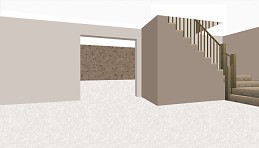
Here is another alternate that I achieved by removing more of the centre wall, duplicating the layer for the shadow area above and moving it to fill in the total area, and finally I used the deformation tool to lengthen the filled back wall to fill up the missing area on the left that appears with the larger opening.
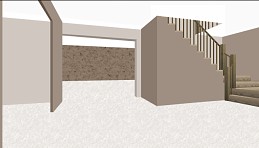
This is one I sampled with using more wallpaper in different areas and I used the fill "phonepole" that came with the programme at size 50 then used the perspective tiling filter to achieve a wood floor look. Since it was a little darker than the stairs I just lightened it up a bit until they looked similar colouring.
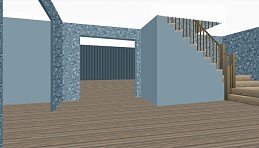
If you have any problems or need further explanations, please feel free to email me here
TUTORIAL PAGE ONE
TUTORIAL PAGE TWO
TUTORIAL PAGE THREE
This tutorial was posted at the site of "P. Ann's Place" January 17, 2004 and written
by Pat Sherman.
All I ask is that you do not claim it as your own or post it on your site without permission.
If you are in a group and want to use this as a lesson, please use the link freely and you do not have to write me to ask permission.
   
|
|